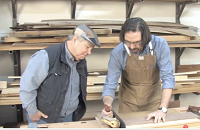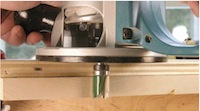We may receive a commission when you use our affiliate links. However, this does not impact our recommendations.
Today is Earth Day, but for the purposes of this article, I’m going to call it Dirt Day. As in dirt-simple woodworking techniques and jigs.
We have a couple of perspectives, from two different woodworkers, up on our web site right now. One is from Christopher Schwarz, courtesy of Highland Woodworker TV. Chris uses a term sometimes applied to a few of my own best friends, relatives and forebears – all Southerners – to name his dirt-simple jigs. Call them whatever you like, because they are really effective, and they require almost no time to build and maintain. I particularly like the thin, flat board – that’s all it is – used to elevate lengthy stock off the bench and ease the process of handplaning a long edge. Chris shows this technique at the tail end of the video.
The other perspective is Glen Huey’s. If you’re a long-time subscriber of the magazine, you may remember his cover article in the November 2008 issue on router jigs. Place Glen’s straightedge jig next to Chris’, and you can see that power-tool woodworking and hand-tool woodworking are not all that different. The same principles apply, and if you’re pretty good at both methods (as both Glen and Chris are), you can start to become super-productive in the shop. The straightedge router jig is nothing more than an inverted form of the long-edge handplane jig, and they are equally easy to set up and use.
Glen wrote a section about the use of the dovetail router bit in that same magazine article. He goes into more detail, and shows us the process, in his most recent DVD, “Building a Carolina Cellarette.” (It’s actually just one of three different methods for cutting dovetails that Glen employs in the video – pretty neat.) In its 2008 version, the technique was categorized as “dirt simple,” but it may or may not have been all that easy to execute in your home shop. Once you’ve seen the video, you’ll see how simple it really is. The project itself is also quite nice. Buy it and build it!
We had a nice conversation going last week on the topic of simplicity. Let’s focus on the technique sub-topic here on Dirt Day. Share a video link or tell us about a jig you use to make your work as easy as it can be, whether you’re at a basic or more advanced level.
– Dan Farnbach
Here are some supplies and tools we find essential in our everyday work around the shop. We may receive a commission from sales referred by our links; however, we have carefully selected these products for their usefulness and quality.











